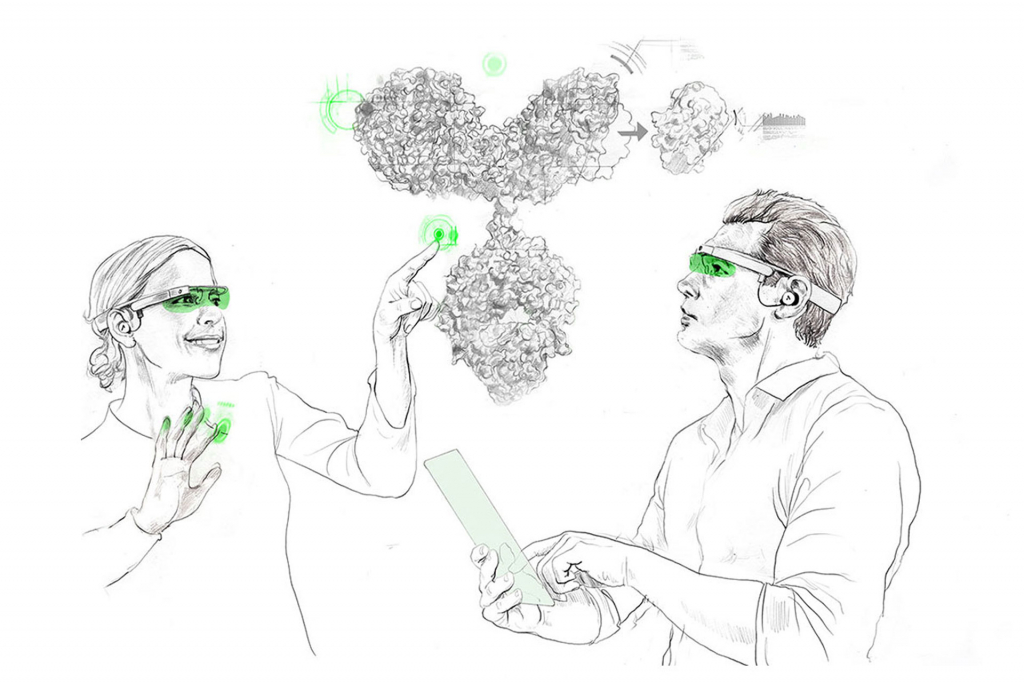From the experimental use of murine antibodies in first clinical trials to the fine-tuning of high-performance recombinant monoclonal antibodies without involvement of B cell derived cell lines, the biotechnology industry has evolved at an incredible rate.
One of the most exciting recent developments in the sector is the engineering of antibodies’ fragment crystallizable (Fc region). Fc engineering entails the optimization of recombinant monoclonal antibodies, anticancer bispecific antibodies1 and Fc fusion proteins by means of modifications at specific residues to enhance performance in their intended applications2.
While the goal might be an increased Fc-mediated recruitment of immune cells, as in glycosylation engineering in glycans for antibody-dependent cellular cytotoxicity (ADCC), Fc engineering can result in completely missing immune effector functions3. Since Fab regions are linked to the Fc domain through the hinge region, such Fc alterations do not hamper epitope binding.
The key advantages are reduced nonspecific background for in vitro epitope specific assays, e.g. immunohistochemistry and surface plasmon resonance (SPR), and in vivo the potential reduction of antitumor therapeutics’ side effects.
Subscribe to our Newsletter
Get all the latest updates, and learn about our advancements in antibody production.
Subscribe now
Fc silencing involves Fc mutations through substitutions in the amino acid sequence of the Fc regions where human Fc gamma receptors of effector cells bind to antibodies. Wild-type Fc is a great ligand for Fc gamma receptors and thus mediates antibody-dependent cell recruitment for immune responses.
Several types of Fc gamma receptors were identified in humans: FcγRI, FcγRIIA, FcγRIIB, FcγRIIC, FcγRIIIA,FcγRIIIB with varying affinities to Fc variants. Immunoglobulin IgG2 and IgG4 isotypes show reduced binding affinity to Fc gamma receptor subclasses, hence exhibiting a reduced immune response.
Noteworthily, Fc silencing does not affect the Fab region. Fc silenced immunoglobulins retain their antigen binding and high affinity to pathogenic target cells resulting in their aggregation.
Fcγ receptors are sensors that are located on several types of immune cells except T cells. They bind either directly to IgG Fc domains or via intermediary proteins (e.g. complement-dependent cytotoxicity (CDC) is mediated through C1q binding). This binding process in turn triggers complex immune effector functions, such as recruitment of macrophages, antibody-dependent cellular phagocytosis (ADCP) and cytokine release, resulting in inflammation states.
On one hand, these processes are key in killing cancer cells as well as pathogens and they are the first step towards healing. On the other hand, immunotherapeutics may cause very strong immune reactions (e.g. cytokine storms) that can be classified as adverse events.
Fc silencing or modulation is a promising avenue to decrease the frequency of such side effects.

Another key function of the Fc domain on antibodies is the regulation of the respective antibodies’ serum half-life and, by extension, the pharmacokinetics of mAb immunotherapeutics. A region of the human IgG1 Fc domain is bound by so-called neonatal Fc receptors and the extent of binding dictates Ab recycling rates. US scientists found that a tenfold increase in FcRn binding correlates to a 4-fold increase in serum half-life4.
Moreover, the Ab aggregation state was found to be important: monomeric or polymeric IgGs exhibit differential receptor binding, hence affecting potential toxicity and immunogenicity of immunotherapeutics.
Harnessing IgG1 antibodies for therapeutic purposes is a well established approach in biopharmaceutics. The Fc domain conveys cytotoxicity, which is often not desired in certain therapeutic approaches. Certain mAb therapeutics’ mode of action does not require:
but merely binding and blocking certain proteins in signaling pathways to modulate a pathologic downstream response.
Hence, any direct antibody dependent activation of the immune system is not desired in such an application. Fc silencing is a feasible approach to regulate the magnitude of immune system activation for such therapies. Recently, minimal point mutations in the linker region between hinge and Fc domains were described to reduce or fully abrogate Fcγ binding affinity and downstream effector cell activation6. This approach is unlikely to influence antigen binding, in turn keeping such variant mAbs effective towards their intended target.

A number of mutations have been described by academic and industrial groups to silence the Fc domain. These vary in their abilities, and have a variety of different IP constraints. The most common IP-free formats use LALA (L234A, L235A) or aglycosylation (N297A and others) modifications. Improvements on these systems have been developed by different industrial groups (e.g. LALAPG from Roche), but are often difficult or very costly to license. The company mAbsolve performed a thorough characterization of its STR antibodies and compared them against other silencing technologies. They performed favorably against the competition across many assays, oftentimes with no measurable activity whatsoever.
Additionally, they investigated their STR antibodies for cytokine release as a proxy for their propensity to cause adverse side effects. STR antibodies performed significantly better than the competitors and were indistinguishable from a buffer solution that acted as negative control.
Source: